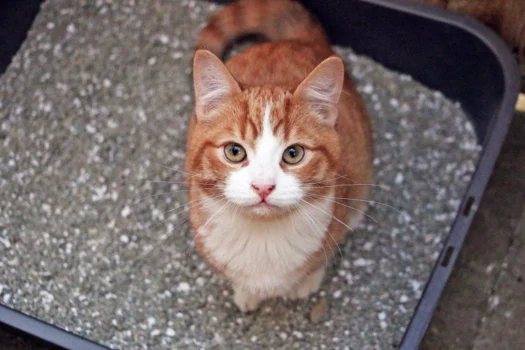Welcoming a new California Spangled Kitten to your home is an exciting time, filled with cuddles, playtime, and a lot of love. However, with any new furry friend comes the responsibility of litter training. While it may seem overwhelming at first, don’t fret! With the right information and approach, you can ensure a stress-free and successful litter training experience for both you and your kitten. In this guide, we’ll cover the dos and don’ts of litter training your California Spangled Kitten, as well as helpful tips for troubleshooting any problems that may arise. So, let’s get started on creating a happy and healthy environment for your furry friend to thrive in.
Understanding Your Kitten’s Litter Box Needs

As a new kitten owner, understanding your feline’s litter box needs is essential for a harmonious coexistence. Not only is it important for your California Spangled Kitten’s hygiene and comfort, but it can also contribute to your bond with your feline friend. In this section, we will cover how to choose the right litter box and litter type to accommodate your kitten’s preferences and needs. We will also discuss tips for successful litter training and provide you with the dos and don’ts to avoid any confusion or mistakes. Finally, we will outline some common litter box problems you might encounter and how to troubleshoot them. Let’s dive in! If you are interested in related topics, positive reinforcement trainingor clicker training might interest you as well.
Choosing the Right Litter Box
Choosing the Right Litter Box for your California Spangled Kitten is one of the most important considerations for successful litter box training. Cats have individual litter box preferences, and ignoring their preferences may lead to unwanted behaviors. Here are some factors to consider when choosing your kitten’s litter box:
| Factor | Considerations |
|---|---|
| Size | The litter box should be large enough for your kitten to move around comfortably. As your kitten grows, you may need to switch to a larger size box. |
| Depth | The litter box should be deep enough to hold an adequate amount of litter. A depth of approximately 3 inches is recommended. |
| Shape | Cats usually prefer rectangular or square-shaped litter boxes with low sides for easy access. Some cats prefer open-type boxes with no cover, while others prefer covered boxes for added privacy. |
| Material | Litter boxes made of plastic are easy to clean and affordable. However, some cats develop preferences for certain materials and may prefer ceramic or metal boxes. |
| Number | You should provide at least one litter box per cat plus an additional one, so two litter boxes for one kitten would be ideal. This ensures that your kitten has ample opportunities to use the litter box, and also helps prevent litter box-related problems. |
| Location | The litter box should be placed in a quiet, low-traffic area of your home that is easily accessible to your kitten. Avoid placing the litter box near food and water bowls, as cats prefer to keep their food and toileting areas separate. |
Ensuring that your kitten’s litter box meets these criteria will make them more likely to use it consistently, and will lead to successful litter box training. Additionally, if you encounter any problems during your kitten’s training, be sure to check their litter box to make sure it is clean, easily accessible, and meets their preferences.
If you want to learn more about teaching tricks to your California Spangled Cat, you can read our article Teaching Tricks for Your California Spangled Cat.
Choosing the Right Type of Litter
Choosing the right type of litter is essential for a successful litter training experience with your California Spangled kitten. There are several types of litter available, but not all of them may be appropriate for your kitten. Some cats have preferences for certain types of litter, while others may have sensitivities or allergies to certain materials. Before choosing litter, consider the texture, scent, and absorbency.
Texture: Cats have preferences for litter textures. Some prefer fine-grained litter, while others prefer a coarser texture. To determine what texture your kitten prefers, you may want to try a few different types of litter and see which one they prefer.
Scent: Some litters are scented to mask odors, while others are unscented. Generally, it’s better to choose unscented litter because strong smells may irritate your kitten’s sensitive nose.
Absorbency: The absorbency of litter is also an important factor to consider. Look for litter that can retain moisture and control odors. You should also consider whether the litter is flushable or not.
Here is a table summarizing the different types of litter available:
| Type of Litter | Texture | Scent | Absorbency |
|---|---|---|---|
| Clay litter | Coarse | Usually scented | High |
| Crystal litter | Coarse | Usually unscented | Very high |
| Paper litter | Soft | Usually unscented | Low |
| Pine litter | Coarse | Natural pine scent | High |
Remember, not all litters are created equal. It’s important to select the right type of litter based on your kitten’s preferences, sensitivities, and the litter’s absorbency. By doing so, you will increase the likelihood of a successful litter training experience.
The Dos of Litter Training Your California Spangled Kitten

Litter training a California Spangled kitten can be a challenging task, but by following the right steps, you can make the process much easier. As a responsible pet owner, it’s important to understand the dos of litter training your California Spangled kitten. By doing so, you can ensure that your kitten learns to use their litter box properly and avoids any unwanted behaviors such as going to the bathroom outside the box. Here are some important things you should know when it comes to the dos of litter training your California Spangled kitten.
Start Early
Starting the litter box training process early is crucial for your California spangled kitten to develop good litter box habits for life. Kittens can start using the litter box as early as four weeks old, and it’s important to use this window.
During this time, your kitten is most impressionable, and they are just beginning to understand the world around them. Introduce your kitten to their litter box during this window, and they’ll soon learn to associate it with going to the bathroom.
To set your kitten up for success, create a consistent routine and stick to it. Bring the kitten to the litter box after every meal, play session, and nap. This way, they’ll learn to associate their litter box with going to the bathroom and learn to use it regularly.
It’s also important to remember that litter box training takes time and patience. Do not rush the process or expect immediate success. Your kitten may have accidents at first, but this is normal and expected. Give them time to learn, and soon they’ll be using their litter box like a pro.
Table: Tips to Start Litter Box Training Early
| Do: | Don’t: |
|---|---|
| Start early, as soon as they’re four weeks old | Rush the process or expect immediate success |
| Create a consistent routine | Yell or punish your kitten for accidents |
| Bring your kitten to the litter box after every meal, play session, and nap | Train your kitten in too big a space |
| Be patient and consistent | Ignoring accidents or not cleaning the litter box regularly |
Starting your California spangled kitten’s litter box training early can save time and prevent headaches down the road. By taking the time to consistently train your kitten, they’ll learn good habits that they’ll keep for their lifetime.
Choose a Quiet Spot
When choosing the perfect spot for your California Spangled kitten’s litter box, it’s important to consider a quiet and peaceful location in your home. This will help your kitten feel comfortable, relaxed, and stress-free while using the litter box. A quiet spot away from loud noises, heavy foot traffic, and other disturbances will make the experience much more enjoyable for your feline friend.
Here are some additional tips to help you choose the perfect location:
- Choose an easily accessible spot that your kitten can easily get to, but not in the middle of high-traffic areas where there may be a lot of noise and disruption.
- Consider keeping the litter box away from your kitten’s food and water bowls as cats generally prefer to keep their eating and bathroom areas separate.
- Make sure the litter box is not too close to any air vents or heating/cooling systems that may cause dust or debris to fly around and potentially on your kitten.
By selecting a spot that is quiet and away from distractions, you are helping your kitten feel comfortable and relaxed during this important transition. Remember, by regularly encouraging and praising your kitten for using the litter box, you can help to reinforce good behavior and set your kitten up for a lifetime of successful litter box use.
If you’re interested in training your California Spangled to walk on a leash, check out our guide on leash training your cat. Additionally, if you’re experiencing any unwanted behaviors from your cat, take a look at our guide on managing unwanted behaviors in California Spangled cats.
Buy the Right Litter Box and Litter
It’s crucial to buy the appropriate litter and litter box for your California Spangled Kitten to ease the process of litter training. Here are some things to keep in mind while selecting the correct litter and litter box.
Litter Box:
- Choose an open litter box initially. Some kittens may fear enclosed spaces that can make them hesitant to go. Once they are comfortable with the open litter box, you can transition to an enclosed one if required.
- The size should be sufficient for your kitten to move around in and for the litter to be easily spread around. A box that’s too small may make your kitten feel uncomfortable.
- Get a litter box without a lid to make it easy for your kitten to access it.
Litter:
- There are a variety of litter options available such as clay, crystal, and paper-based. Begin with a basic litter that doesn’t have any strong fragrances to get your kitten used to the box’s smell.
- Determine the kind of litter your kitten prefers by observing them. Some kittens like fine-grained litter, while others prefer chunkier litter.
- Choose a litter that’s dust-free to prevent any respiratory problems for both you and your kitten.
When selecting both the litter box and litter for your California Spangled Kitten, keep in mind that consistency is essential. Once you have picked a litter and litter box that work for your kitten, continue to use the same one. If you need to transition to a new litter or litter box, do it gradually and in small steps to prevent issues from arising.
Show Your Kitten How to Use the Litter Box
It is important to show your California Spangled kitten how to use the litter box to ensure that they understand where they should go to do their business. Here are some steps you can take to teach your kitten how to use the litter box:
- Place your kitten in the litter box: Gently place your kitten in the litter box and let them sniff around. They may start to crawl in the litter or play with it, but that’s okay. Allow them to explore their new environment.
- Repeat the process: If your kitten doesn’t use the litter box within 10-15 minutes, take them out and try again later. Repeat this process until they use the box on their own.
- Praise your kitten: When your kitten does use the litter box, praise them with a gentle pat and a kind word. This positive reinforcement will encourage them to use the box consistently.
- Keep the litter box clean: Your kitten is more likely to use the litter box if it is clean and fresh. Scoop the litter box daily and change the litter every week.
Remember, teaching your kitten how to use the litter box is a process that takes time. Be patient and consistent, and your California Spangled kitten will learn the ropes of litter training in no time.
Be Patient and Consistent
When it comes to litter training your California Spangled kitten, it’s important to remember to be patient and consistent. It may take some time for your kitten to fully understand how to use the litter box, but with patience and consistency, you’ll get there. Here are some tips to help you stay patient and consistent during the litter training process:
- Stick to a Routine: Create a routine for your kitten and stick to it. This includes feeding times, playtime, and litter box breaks. Try to keep the routine consistent day-to-day, as this can help your kitten feel more secure and confident.
- Positive Reinforcement: Reward your kitten every time they use the litter box appropriately. This can be in the form of treats, praise, or playtime. Positive reinforcement will help your kitten associate using the litter box with good feelings and outcomes.
- Stay Calm: Accidents may happen, but it’s important to stay calm and not react too strongly. Punishing your kitten for using the bathroom outside the litter box can cause anxiety and confusion, which can make training more difficult. Instead, try to redirect your kitten to the litter box and positively reinforce their good behavior.
- Watch for Signs of Distress: If your kitten is showing signs of distress or discomfort when using the litter box, it’s important to address the issue right away. This may mean changing the type of litter or litter box, or even consulting with your vet.
- Stay Consistent: Don’t give up on litter training your kitten. Even if there are setbacks, stay consistent with your routine and positive reinforcement. Eventually, your kitten will understand and adjust to using the litter box regularly.
Remember, litter training your California Spangled kitten takes patience and consistency, but with these tips, you’ll be on your way to a happy and litter-trained feline friend.
The Don’ts of Litter Training Your California Spangled Kitten

As much as it’s important to know what to do when litter training your California Spangled Kitten, it’s equally important to know what not to do. To avoid inadvertently confusing or frustrating your furry friend, it’s worth noting the common don’ts when it comes to litter box training. Here are some things you should avoid doing to ensure a successful experience for both you and your kitten. Let’s dive in and explore them.
Don’t Yell or Punish Your Kitten
It’s important to understand that your California Spangled kitten is still learning proper litter box etiquette and may make mistakes along the way. However, it’s crucial that you do not resort to yelling or punishing your furry friend. Shaming or physically punishing your kitten for accidents will not only be ineffective, but it can also induce fear and anxiety in your pet. This can lead to your kitten associating the litter box with negative emotions and becoming scared or anxious of using it.
Instead of using punishment, use positive reinforcement when your kitten uses the litter box correctly. Praise them with a gentle pet or a treat to let them know they did well. This will encourage them to repeat the desired behavior and create a positive association with the litter box.
Yelling or punishing your kitten may also cause them to become defensive or aggressive towards you. This can make your bond with your pet more difficult and can hinder the progress of litter training. Always keep in mind that your kitten is still learning and requires patience and positive reinforcement to reach their goals.
Remember, being a responsible pet owner is not only about providing food and shelter but also about providing a safe and stress-free environment for your furry friend to grow and thrive in. So, stay calm, patient, and use positive reinforcement to help your California Spangled kitten succeed in their litter training.
Don’t Litter Box Train Your Kitten in Too Big a Space
When it comes to litter box training your California Spangled kitten, it is important to choose the right space for their litter box. Training your kitten in too big a space can actually make the process more difficult and lead to accidents. This is because kittens need to have a clear understanding of where their litter box is and how to use it.
One of the biggest mistakes that some cat owners make is allowing their kitten access to the whole house too soon. This can overwhelm a kitten and make it difficult for them to locate their litter box. It is important to start small and gradually increase the space your kitten has access to. A good way to do this is to confine your kitten to one room or area of the house at first.
Once your kitten has mastered using their litter box in a smaller space, you can gradually give them access to more areas of the house. However, it is important to keep an eye on your kitten’s behavior and make sure they continue to use the litter box. If you notice accidents, it may be a sign that you need to limit your kitten’s access to certain areas until they are fully litter box trained.
Here are some tips to help you avoid litter box training your kitten in too big a space:
- Start small with just one room or area of the house
- Gradually give your kitten access to more areas only after they have mastered using the litter box in a smaller space
- Keep a close eye on your kitten’s behavior and limit their access to certain areas if needed
By following these tips, you can help ensure that your California Spangled kitten is properly litter box trained in an appropriate space.
Don’t Ignore Accidents
It’s important to understand that accidents are bound to happen during the litter training process, but ignoring them can lead to bigger problems down the line. Accidents should never be ignored or dismissed as ‘just a one-time thing’. If your kitten has an accident outside of the litter box, it’s important to clean it up thoroughly to remove any scent that may attract them to use the same area again.
To properly clean up an accident, start by using paper towels to blot up as much urine or feces as possible. Then, use an enzymatic cleaner specifically designed for pet stains to thoroughly clean the area. These cleaners break down the bacteria and enzymes in the waste, eliminating the scent that may draw your kitten back to the same spot.
Ignoring accidents can lead to your kitten thinking it’s okay to go to the bathroom outside of the litter box, causing a setback in their litter training progress. It can also lead to inappropriate elimination habits developing, which can be much more difficult to correct.
If accidents continue to happen, it may be a sign that something isn’t quite right with the litter box setup or your kitten’s health. Be sure to address any underlying issues and give your kitten plenty of positive reinforcement when they successfully use the litter box.
Troubleshooting Litter Box Problems
As much as we try to provide a comfortable and welcoming litter box environment for our California Spangled kittens, some problems may still arise. Don’t worry, this is perfectly normal and can be easily resolved with a bit of troubleshooting. In this section, we’ll discuss some common litter box problems that you may encounter, and provide helpful tips on how to resolve them. So, let’s explore some possible dilemmas and their solutions to ensure that your kitten stays happy and comfortable while doing their business.
What to Do if Your Kitten Uses the Bathroom Outside the Litter Box
It can be frustrating when your California Spangled kitten uses the bathroom outside of their litter box. However, it is important to handle the situation with care in order to properly train your kitten. Here are some steps you can take if your kitten is having accidents outside of their litter box:
| Step | Action |
|---|---|
| Step 1 | Stay calm and do not yell or punish your kitten. This can cause anxiety and further litter box avoidance. |
| Step 2 | Clean up the mess immediately. Use an enzymatic cleaner specifically designed for pet accidents to remove the urine or feces odor from the area. This will also help prevent your kitten from revisiting the spot. |
| Step 3 | Monitor your kitten closely. If the accidents continue, it may be a sign of an underlying health issue. Schedule a vet appointment to rule out any medical problems. |
| Step 4 | Assess the litter box situation. Is the box clean and in a comfortable location? Is the litter type appealing to your kitten? Make any necessary changes in order to encourage litter box use. |
| Step 5 | Consider confining your kitten to a smaller area, such as a bathroom, with their litter box for a short period of time. This can help establish litter box habits and prevent accidents outside of the designated area. |
| Step 6 | Offer positive reinforcement when your kitten uses the litter box properly. This can be in the form of treats or verbal praise. This helps your kitten develop a positive association with the litter box. |
Remember that litter box training takes patience and consistency. By following these steps and providing a comfortable and appealing litter box environment, you can successfully train your California Spangled kitten.
What to Do if Your Kitten Refuses to Go into the Litter Box
When your California Spangled Kitten refuses to use the litter box, it can quickly become frustrating. However, it’s essential to understand that this behavior is not uncommon and can be traced back to a variety of reasons. Here are some steps to take if your kitten refuses to go into the litter box:
| Step | Action |
|---|---|
| Step 1 | Check the litter box |
| Step 2 | Check the litter |
| Step 3 | Place the kitten in the litter box |
| Step 4 | Be patient and consistent |
Step 1: Check the litter box. Sometimes the reason for your kitten’s refusal to use the litter box can be as simple as a dirty or uncomfortable box. Ensure that the litter box is clean, free of any odors, and easy for your kitten to access. Make sure that the box is in a private and quiet location to provide your kitten with the necessary privacy.
Step 2: Check the litter. Your kitten may refuse to use the litter box if the litter is uncomfortable or not the right type. It’s essential to remember that some cats prefer different types of litter. Experiment with various litter types to find the one your kitten prefers. Also, ensure that you use enough litter and that it’s changed regularly.
Step 3: Place the kitten in the litter box. If your kitten refuses to go into the litter box, gently place them inside. You can also try placing some of their waste in the litter box to show them that it’s where they are supposed to go.
Step 4: Be patient and consistent. Litter box training takes time, and it’s essential to be consistent and patient with your kitten. Avoid punishing or yelling at your kitten as this can lead to more fear and anxiety. Instead, praise and reward them when they use the litter box correctly.
Taking these steps can help you train your California Spangled Kitten to use the litter box. It’s essential to remember that litter box training can take time, and it’s crucial to be patient and consistent with your kitten. If the problem persists, consult your veterinarian for further guidance.
What to Do if Your Kitten Doesn’t Cover Their Waste
It’s not uncommon for kittens to leave their waste uncovered in the litter box, which can create unpleasant odors and a mess. However, there are several ways to encourage your California Spangled kitten to cover their waste.
Reconsider the Type of Litter
If your kitten isn’t covering their waste, it could be due to the type of litter you use. Some kittens are sensitive to certain textures or scents, and may avoid covering their waste if they don’t like the litter. Consider switching to a different type of litter to see if your kitten responds better. You could also try adding a small amount of unscented litter to their preferred type to encourage covering behavior.
Adjust the Depth of the Litter
Another factor to consider is the depth of the litter. If it’s too shallow, your kitten may have difficulty covering their waste effectively. On the other hand, if the litter is too deep, it could be uncomfortable for them to dig and cover their waste. Find a happy medium by adding or removing small amounts of litter at a time until you find the right depth that encourages covering behavior.
Provide Positive Reinforcement
It’s important to positively reinforce good litter box behavior. When your kitten covers their waste, offer them praise, treats, or affection to reinforce the behavior. Conversely, avoid scolding or punishing them when they don’t cover their waste, as this can create anxiety and deter them from using the litter box.
Consider Placement of the Litter Box
Finally, consider the placement of the litter box in your home. If it’s tucked away in a corner or a closet, your kitten may not feel as comfortable using it. Try moving the litter box to a more open and accessible area of the home to encourage your kitten to use it more regularly and cover their waste.
By trying different approaches, you can encourage your California Spangled kitten to cover their waste and develop good litter box habits. Remember to be patient and persistent in your training efforts, and to provide positive reinforcement for good behavior.
Conclusion
It’s important to remember that litter training your California Spangled kitten can take some time and patience. However, by following the dos and don’ts discussed in this article, you can effectively litter train your kitten. Remember to choose the right litter box and litter, start training early, and be patient and consistent. It’s imperative that you never yell or punish your kitten during training and never train them in too big of a space. Accidents will happen, but it’s important not to ignore them and to address any issues promptly.
If your kitten is having trouble adapting to the litter box, there are troubleshooting techniques you can utilize. If your kitten isn’t using the litter box or doesn’t cover their waste, consider changing the type of litter you’re using or try a different litter box. If accidents outside the box occur, try placing them back in the litter box or providing them with a second litter box in a different location.
Ultimately, successfully litter training your California Spangled kitten will benefit both you and your pet. It will help keep your home clean and your kitten happy and healthy. So don’t get discouraged and keep at it- with time and effort, you’ll have a litter-trained kitten in no time.
Frequently Asked Questions
What age should I begin litter training my California Spangled kitten?
It’s best to start litter training your kitten when they’re between 4-6 weeks old.
What type of litter box is best for my California Spangled kitten?
A covered litter box is usually preferred by most cats, but for larger cats, an uncovered litter box may be more appropriate. Also, make sure the sides of the litter box are not too high.
What kind of litter should I use to litter train my California Spangled kitten?
Choosing a soft and unscented litter is recommended to avoid irritating your kitten’s sensitive nose and paws.
Where should I place the litter box in my house?
The litter box should be placed in a quiet and private area, away from high-traffic areas, where your kitten will feel safe and comfortable.
How do I show my California Spangled kitten how to use the litter box?
Place your kitten in the litter box right after they finish eating or after waking up from a nap. Gently scratch the litter with your finger to demonstrate how to cover waste. Repeat this process consistently until your kitten starts using the litter box independently.
What should I do if my California Spangled kitten has an accident outside of the litter box?
Use an enzyme-based cleaner to clean up any accidents, as regular cleaners can leave a scent that may attract your kitten to go to the bathroom in the same spot again.
Should I punish my California Spangled kitten if they have an accident outside the litter box?
No, punishment can cause fear and anxiety in your kitten, which can lead to further litter box avoidance. Instead, try to identify the reasons behind the accident and address them accordingly.
What should I do if my California Spangled kitten refuses to use the litter box?
If your kitten continues to refuse to use the litter box, try changing the type of litter or litter box. Also, consult with a veterinarian to rule out any underlying medical issues.
How often should I clean the litter box?
It’s recommended to scoop the litter box at least once a day to remove any waste. The litter box should be fully cleaned and changed every 1-2 weeks.
What should I do if my California Spangled kitten doesn’t cover their waste?
Some cats don’t cover their waste because they feel safe and secure in their environment. However, if it’s becoming a problem, try switching to a different type of litter or litter box, or placing an additional litter box in a different location.







